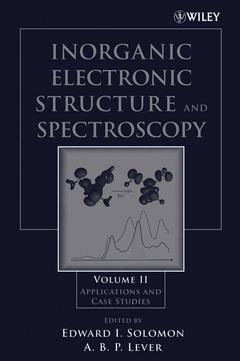Inorganic Electronic Structure and Spectroscopy, Volume II Applications and Case Studies Inorganic Electronic Structure and Spectroscopy Series

This newly available paperbound edition of Inorganic Electronic Structure and Spectroscopy includes all the material from the original clothbound edition published in 1999. Consisting of articles contributed by outstanding scientists from around the world, Volume II, Applications and Case Studies represents the state of the art in this field, written in a style accessible to the well-read senior undergraduate, and yet still of superior value to the senior researcher.
The second of a two-volume set, Volume II explores various compounds of interest in inorganic chemistry and describes their electronic structures from the perspective of spectroscopic studies. Areas discussed include:
* Bioinorganic Spectroscopy
* Mixed Valence
* Multiple Metal-Metal Bonds
* Transition Metal Nitrosyls
* Electronic Structure of Heme Sites
* Spin Transition in Iron (II) Compounds
* Neutron and Optical Spectra of Magnetically Ordered Crystals
This work assumes a basic understanding of quantum chemistry and group theory. Although written by multiple contributors, the editors' holistic approach to the manuscript has ensured a uniform presentation.
Contributors, Volume II.
Contents, Volume I.
Contributors, Volume I.
1. Bioinorganic Spectroscopy (E. Solomon & M. Hanson).
2. Electron-Transfer Reaction Rate Theory (D. Richardson).
3. Mixed Valence (P. Schatz).
4. Electrochemistry, Charge transfer Spectroscopy, and Electronic Structure (A. Lever & E. Dodsworth).
5. The Photophysics and Photochemistry of Coordination Compounds (J. Endicott).
6. Multiple Metal-Metal Bonds (V. Miskowski, et al.).
7. Transition Metal Nitrosyls (B. Westcott & J. Enemark).
8. Electronic Structure of Heme Sites (G.Loew).
9. Characterization of the Electronic Structure of Transition Metal Carbonyls and Metallocenes (N. Gruhn & D. Lichtenberger).
10. Spin Transition in Iron (II) Compounds (P. Gütlich, et al.).
11. Neutron and Optical Spectra of Magnetically Ordered Crystals (P. Day).
Index.
Alfred Barry P. Lever is a Distinguished Research Professor (Emeritus) in the Department of Chemistry at York University in Toronto. He received his Ph.D. in 1960, from the Imperial College of Science and Technology in London. He is the Founding Editor of the journal Coordination Chemistry Reviews. This journal offers rapid publication of review articles on topics of current interest and importance in coordination chemistry, which includes aspects of organometallic, theoretical and bioinorganic chemistry. Professor Lever was, amongst other things, a Killam Research Fellow from 2000 through 2002, and was the 2002 recipient of the prestigious Linstead Award for Career Achievements in Phthalocyanine Chemistry.
Date de parution : 02-2006
Ouvrage de 672 p.
15.5x23.8 cm
Thème d’Inorganic Electronic Structure and Spectroscopy :
Mots-clés :
paperbound; inorganic; edition; material; electronic; available; spectroscopy; chemical education; contributed; outstanding scientists; around; world; articles; art; state; field; represents; applications; style; undergraduate; senior; accessible



